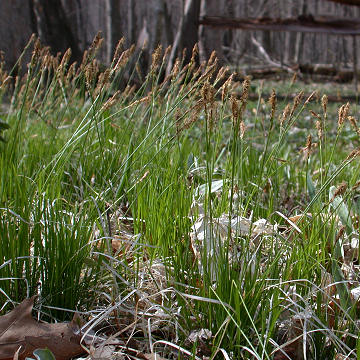

Carex pensylvanica - (image 1 of 6)
Taxonomy
Family: Cyperaceae
Section Acrocystis
Habitat
Dry woods, prairies, oak savannas. Fire adapted
Associates
Distribution
NY and southern ME south to VA and in mountain to TN and NC, west to southern Saskatchewan, British Columbia, WA, CA, OR, and NM.
Morphology
In small to large tufts, forming sizable colonies from long rhizomes, to 50 cm; leaves 1-3 mm wide, the margins scabrous; terminal spike staminate, 1-2.5 cm long; pistillate spikes 1-3, sessile or on short peduncles, to 1.5 cm; lowest bract 1-3 cm, exceeded by the terminal spike; pistillate scales purplish, brownish or straw-colored, obtuse to acuminate; perigynia to 4.5 mm, short-hairy, 2-keeled and nerved, subglobose, the beak short and straight, 0.2-1.0 mm, ending in two teeth; achene rounded-trigonous.
Notes
Fruiting early May to June
Wetland indicator: NA
One of the earliest woodland sedges to bloom in the spring. The bright yellow stamens are said to be quite showy, although I always seem to catch them after they have withered. The dry leaves of the previous year persist and serve to fuel surface fires.
References
Curtis, L. 2006. Woodland Carex of the upper Midwest. Lake Villa, IL.
Gleason, Henry A. and A. Cronquist. 1991. Manual of Vascular Plants of
Northeastern United States and Adjacent Canada. Second Ed.
The New York Botanical Garden. Bronx, NY
Swink, F. and G. Wilhelm. 1994. Plants of the Chicago Region.
Indiana Academy of Science. The Morton Arboretum. Lisle, Illinois.
|
© Michael Hough 2010 |